

World Wide Web. The World Wide Web (abbreviated as WWW or W3,[3] commonly known as the web) is a system of interlinked hypertext documents accessed via the Internet.

With a web browser, one can view web pages that may contain text, images, videos, and other multimedia and navigate between them via hyperlinks. History[edit] In the May 1970 issue of Popular Science magazine, Arthur C. Clarke predicted that satellites would someday "bring the accumulated knowledge of the world to your fingertips" using a console that would combine the functionality of the photocopier, telephone, television and a small computer, allowing data transfer and video conferencing around the globe.[10] On March 12, 1989, Tim Berners-Lee wrote a proposal that referenced ENQUIRE, a database and software project he had built in 1980, and described a more elaborate information management system.[11] Tim Berners-Lee. Sir Timothy John "Tim" Berners-Lee, OM, KBE, FRS, FREng, FRSA, DFBCS (born 8 June 1955),[1] also known as TimBL, is an English computer scientist, best known as the inventor of the World Wide Web.
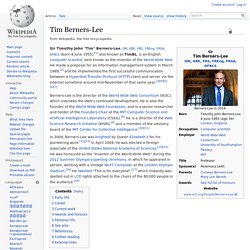
He made a proposal for an information management system in March 1989,[2] and he implemented the first successful communication between a Hypertext Transfer Protocol (HTTP) client and server via the Internet sometime around mid-November of that same year.[3][4][5][6][7] Robert Cailliau. WWW's historical logo designed by Robert Cailliau Biography[edit] Cailliau was born in Tongeren, Belgium.

In 1958 he moved with his parents to Antwerp. After secondary school he graduated from Ghent University in 1969 as civil engineer in electrical and mechanical engineering (Dutch: Burgerlijk Werktuigkundig en Elektrotechnisch ingenieur). He also has an MSc from the University of Michigan in Computer, Information and Control Engineering, 1971. During his military service in the Belgian Army he maintained Fortran programs to simulate troop movements.[3] In December 1974 he started working at CERN as a Fellow in the Proton Synchrotron (PS) division, working on the control system of the accelerator.
In 1993, in collaboration with the Fraunhofer Gesellschaft Cailliau started the European Commission's first web-based project for information dissemination in Europe (WISE). Awards[edit] References[edit] External links[edit] Paul Kunz. Particle physicist and software developer Paul Kunz initiated the deployment of the first web server outside of Europe.
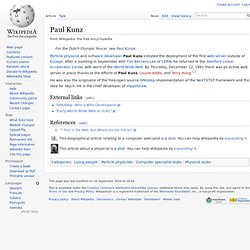
After a meeting in September with Tim Berners-Lee of CERN, he returned to the Stanford Linear Accelerator Center with word of the World Wide Web. By Thursday, December 12, 1991 there was an active web server in place thanks to the efforts of Paul Kunz, Louise Addis, and Terry Hung.[1] He was also the originator of the free/open source GNUstep implementation of the NeXTSTEP framework and the idea for objcX.
Hypertext Transfer Protocol. The Hypertext Transfer Protocol (HTTP) is an application protocol for distributed, collaborative, hypermedia information systems.[1] HTTP is the foundation of data communication for the World Wide Web.
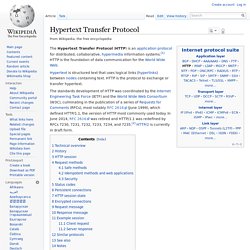
The standards development of HTTP was coordinated by the Internet Engineering Task Force (IETF) and the World Wide Web Consortium (W3C), culminating in the publication of a series of Requests for Comments (RFCs), most notably RFC 2616 (June 1999), which defined HTTP/1.1, the version of HTTP most commonly used today. In June 2014, RFC 2616 was retired and HTTP/1.1 was redefined by RFCs 7230, 7231, 7232, 7233, 7234, and 7235.[2] HTTP/2 is currently in draft form. Technical overview[edit] URL beginning with the HTTP scheme and the WWW domain name label. A web browser is an example of a user agent (UA). HTTP is designed to permit intermediate network elements to improve or enable communications between clients and servers. Gopher (protocol) The Gopher protocol /ˈɡoʊfər/ is a TCP/IP application layer protocol designed for distributing, searching, and retrieving documents over the Internet.
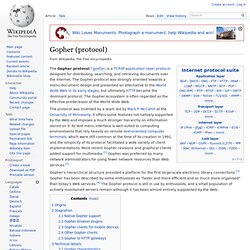
The Gopher protocol was strongly oriented towards a menu-document design and presented an alternative to the World Wide Web in its early stages, but ultimately HTTP became the dominant protocol. The Gopher ecosystem is often regarded as the effective predecessor of the World Wide Web. The protocol was invented by a team led by Mark P. McCahill at the University of Minnesota. Mosaic (web browser) Mosaic was developed at the National Center for Supercomputing Applications (NCSA)[5] at the University of Illinois Urbana-Champaign beginning in late 1992.
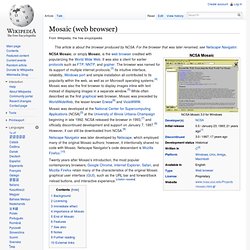
NCSA released the browser in 1993,[7] and officially discontinued development and support on January 7, 1997.[8] However, it can still be downloaded from NCSA.[9] Netscape Navigator was later developed by Netscape, which employed many of the original Mosaic authors; however, it intentionally shared no code with Mosaic. Netscape Navigator's code descendant is Mozilla Firefox.[10] Mosaic 1.0 running under System 7.1, displaying the Mosaic Communications Corporation (later Netscape) website. Development of Mosaic began in December 1992. NCSA Mosaic 3.0. Joseph Hardin: NCSA Mosaic.